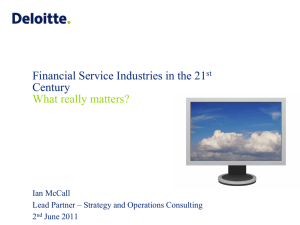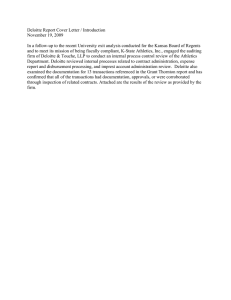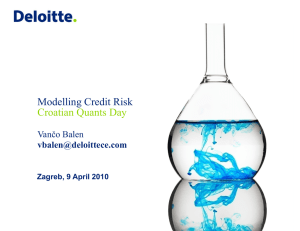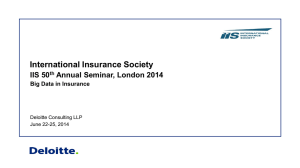Financial due diligence CA. Rajesh S Shetty February 2012
advertisement
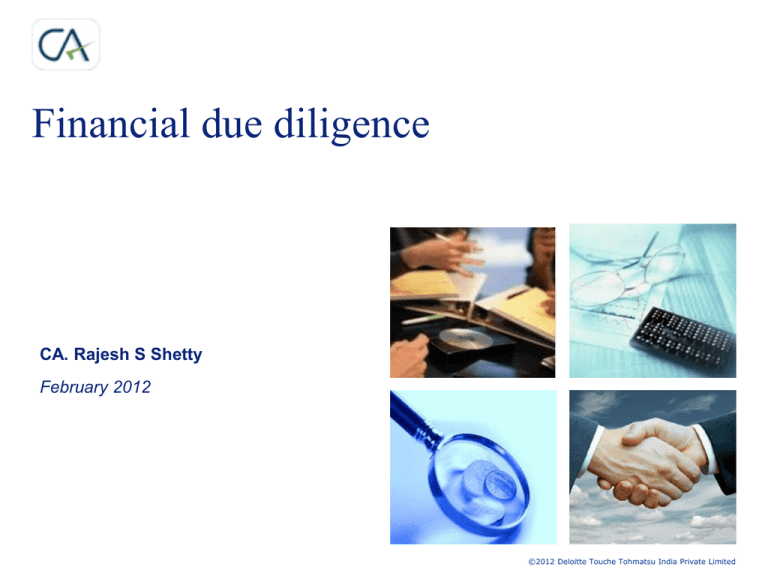
Financial due diligence CA. Rajesh S Shetty February 2012 ©2012 Deloitte Touche Tohmatsu India Private Limited Contents • Background • What is financial due diligence? • Types of financial due diligence • The process • Focus areas • Key benefits • Limitations 2 ©2012 Deloitte Touche Tohmatsu India Private Limited Background • Businesses are positioning them strategically to meet the current challenges of this global economy. • Businesses are entering into cross border alliances to broad base their networks. • Industries are going through phases of consolidation and reorganization. • Businesses are diversifying to spread risk functionally and globally. The changing business equation and the complexity in transactions makes focused/ informed decisions imperative. ©2012 Deloitte Touche Tohmatsu India Private Limited Need of Due diligence Mostly sought for the following transactions: • Acquisition of shareholding interest by a strategic investor • Acquisition of an undertaking / business • Investment by private equity funds • Inbound and overseas investments The changing business equation and the complexity in transactions makes focused/ informed decisions imperative. ©2012 Deloitte Touche Tohmatsu India Private Limited Contents • Background • What is financial due diligence? • Types of financial due diligence • The process • Focus areas • Key benefits • Limitations 5 ©2012 Deloitte Touche Tohmatsu India Private Limited What is financial due diligence? A measure of prudence or assiduity, as is properly to be expected from, and ordinarily exercised by, a reasonable and prudent man under the particular circumstance. • Defined as “an investigation into the affairs of an entity prior to its acquisition, flotation, restructuring or other similar transaction.” • The process by which information is gathered about: – a target company – its business; and – the environment in which a target company operates. • The objective is to ensure that prospective investors make an informed investment decision. …Blacks law dictionary 6 ©2012 Deloitte Touche Tohmatsu India Private Limited What is financial due diligence? It is not just: - Checking the facts - Reciting them Its about: - Evaluation - Interpretation • A business oriented analysis and not an accounting analysis. • A fact gathering exercise with a focused analysis of information. • Understanding the industry of the target. • Reasonable level of enquiry into the affairs having a material impact on the prospects of the business. • Evaluation of the business model and key business practices. • Examination of relevant aspects of the past, present and near future of the business. • Assessment of the benefits and liabilities of the proposed transaction. - Communication 7 ©2012 Deloitte Touche Tohmatsu India Private Limited Contents • Background • What is financial due diligence? • Types of financial due diligence • The process • Focus areas • Key benefits • Limitations 8 ©2012 Deloitte Touche Tohmatsu India Private Limited Types of financial due diligence • • Buy side • • • • • Due diligence commissioned by the acquirer Focused on areas of interest for potential acquirers (financial or strategic) Reporting – generally issue based Auction < > exclusive “Vendor Due Diligence” Commissioned by the vendor Key tool for maximizing success of the transaction in a reduced timetable through maintaining competitive tension Sell side 9 ©2012 Deloitte Touche Tohmatsu India Private Limited Vendor Due Diligence It is It is not Independent due diligence commissioned by the vendor Sales-focussed in the same way as an Information Memorandum Focused on areas of interest for potential acquirers A form of audit Duplication of other reports commissioned by the vendor Identifies potential “show stoppers” early allowing an effective strategy to be devised Sharing of reports - use of hold harmless letters. Reliance on report by investors. ©2012 Deloitte Touche Tohmatsu India Private Limited Types of financial due diligence • Focus on certain key areas based on the level of comfort desired by Client. • Carve out - strictly limited to the part of business proposed to be sold. • Focus on all major aspects of financial statements • Extent of focus and coverage is more comprehensive. Limited Full scale It is important to know what’s driving value for your clients 11 ©2012 Deloitte Touche Tohmatsu India Private Limited Evolution: Investor expectations Markets in the past • Full access and exclusivity in processes • Significant information available • Significant access to management • Completion accounts and purchase price adjustments • Adequate time to discuss, deliberate and negotiate due diligence findings Markets today • Competitive multi stage auctions • Vendor due diligence prevalent • Limited additional information • Limited access to management and managed Q & A processes pre exclusivity • Move towards locked box mechanisms What clients want • Top up due diligence • Focused reporting on what is important • Short lead times for completion of work • Contribution to all aspects of the process including the valuation model • Opinions • Ability to be able to share our reports with various stakeholders including financing providers ©2012 Deloitte Touche Tohmatsu India Private Limited Contents • Background • What is financial due diligence? • Types of financial due diligence • The process • Focus areas • Key benefits • Limitations 13 ©2012 Deloitte Touche Tohmatsu India Private Limited The process Quick Appraisal Terms of Reference Information Checklist Field Work Issue of Final Report Identifying Issues Replies from Management Preparation of Draft Report Discussion of Draft Report “The steps involve an interface with management and other advisors to ensure that all aspects of the project are duly considered and reviewed. This is a pre-requisite for a well informed decision.” 14 ©2012 Deloitte Touche Tohmatsu India Private Limited The process • Pre due diligence information • Timing of exercise • Resources Experienced deal professionals Access to industry and functional specialists with transaction experience Technical thought leadership • Integrated teams • Focus on issues important to clients ©2012 Deloitte Touche Tohmatsu India Private Limited The process • Logistics Data room considerations Paper < > electronic Deadlines • Interactions with statutory auditors • Site visits • Consult, collaborate, and communicate • Confidentiality ©2012 Deloitte Touche Tohmatsu India Private Limited Quality of information • Lack of critical information - product wise/ customer wise margins, monthly /quarterly working capital etc. • Public listed companies – Insider Trading Regulations. • Information largely received through oral discussions. • Reconciliation of MIS and audited financial statements. • Unaudited/provisional financial statements • Disclosure of related parties and transactions with such entities. ©2012 Deloitte Touche Tohmatsu India Private Limited Contents • Background • What is financial due diligence? • Types of financial due diligence • The process • Focus areas • Key benefits • Limitations 18 ©2012 Deloitte Touche Tohmatsu India Private Limited Focus areas Quality of earnings, gross margin & cash flows Quality of assets & working capital Separation/ structuring/ integration Issues Potential liabilities & commitments Net debt Other matters Co-ordination with other work streams is very important. It is an iterative process requiring prompt communication of and acting on findings. 19 ©2012 Deloitte Touche Tohmatsu India Private Limited Focus areas Deal fundamentals • Business environment - markets, competition, regulations • Public listed company • Third party interests - ROFR • Sale of business < > sale of shares of the target Carve out of financial statements Carve out of assets and liabilities Tax considerations ©2012 Deloitte Touche Tohmatsu India Private Limited Focus areas Quality of earnings, gross margin & cash flows • Identifying seasonality in sales. • Dependency on customers/suppliers. • Assessing the impact of customers gained / lost on the bottom line. • Trend in gross margins – rate of growth; sustainability • Impact of changing costs on margins (ability to pass through) • Impact of stand alone costs. • Impact of foreign exchange rate fluctuations. ©2012 Deloitte Touche Tohmatsu India Private Limited Focus areas Quality of earnings, gross margin & cash flows • Application/consistency of GAAP • Revenue recognition and cut off procedures • „Normalized‟, „pro-forma‟, „adjusted‟ EBITDA • Items of one off / non recurring nature • Expenses not incurred exclusively for the business • Cash flows from operations - stability, timing and certainty ©2012 Deloitte Touche Tohmatsu India Private Limited Focus areas Quality of assets – fixed assets • Historical capex; growth and maintenance capex. • Capital WIP – potential commitments. • Assets on lease – potential increase in lease premium in case of change of control. • Depreciation policy - assets fully deprecated still being used. • Capitalization of „soft costs‟. • Capacity constraints to meet operating growth projections • Assets used but not owned; owned but not used ©2012 Deloitte Touche Tohmatsu India Private Limited Focus areas Quality of assets - working capital • Working capital: seasonality and impact on financing considerations; „normal/average levels‟. • Working capital: quality of receivables and inventories. – Realization in the short term - receivables outstanding over six months – Valuation of work in progress • „Fixed working capital‟ - deposits with tax authorities and retention money. • Treatment and presentation of cheques issued but not cleared. • Differences in accounting policy – Client < > Target ©2012 Deloitte Touche Tohmatsu India Private Limited Focus areas Net Debt • Definition of „net debt‟: surplus cash, investments – transaction is on a debt free / cash free basis • Debt-like items (pension underfunding, severance and other non-operating liabilities) • Negative covenants in loan agreements/ sanction letters (change of control) • Compliance with terms of debt restructuring schemes • Impact of right of recompense of lenders in respect of waivers, reliefs and concessions granted to the Target ©2012 Deloitte Touche Tohmatsu India Private Limited Focus areas Potential liabilities & commitments • Provisioning policy – qualitative (aggressive / conservative) • Contingent liabilities and off balance sheet items • Change of control matters (financing, employees, key agreements, etc.) • Pension and related obligations • Forward outlook (capex, backlog, etc.) • Earn outs / contingent consideration from prior business combinations ©2012 Deloitte Touche Tohmatsu India Private Limited Focus areas Separation/ Structuring/ Integration Issues • Synergies • MIS and accounting systems • Transition services agreement • Standalone considerations (impact of economies of scale, support functions) • Potential changes in supply chain management • Integration issues ©2012 Deloitte Touche Tohmatsu India Private Limited Focus areas Related party transactions • Financial appropriateness of transactions within family run businesses (arms length pricing). • Target operating within a „group‟. • Sharing of resources / common costs • Financing arrangements with related parties. Human resources • Provision/funding of gratuity and leave encashment. • Contractual employees; casual labour. • Retention of key employees. ©2012 Deloitte Touche Tohmatsu India Private Limited Focus areas Tax • Compliance of conditions attached to tax benefits. • Assessment of disputed demands: – „contingent‟ (though the likeliness of the company succeeding would be remote). – indirect tax litigation • Transfer pricing - impact of proposed transaction • Delay in payment of taxes – interest/penalties • Expenses disallowed – continuing stand of tax authorities ©2012 Deloitte Touche Tohmatsu India Private Limited Focus areas Financial investor Strategic investor • • • • • • • Historical earnings Quality of assets and liabilities Contingent liabilities GAAP effects on consolidation and effect on EPS Fit with current tax structure Synergy and integration risks • • • • • • Cash flows – sustainability/ reliability Strong and clear track record of Normalised EBITDA Normalised working capital, net debt Assumptions behind projections Capex – present and future Quality of management Quality and capacity of IT systems However, needs are converging very quickly... 30 ©2012 Deloitte Touche Tohmatsu India Private Limited Due diligence findings Anticipate problems and opportunities – Early identification of and discussion of preliminary issues with client Measure exposures and seek solutions – Quantify estimated amounts and likelihood of exposures resulting in future cash outflows (range/sensitivity analysis) Interpret findings in ways clients can use – Focus on material issues – Use plain English – many of the decision makers at clients will not understand or appreciate a detailed technical GAAP or tax answer to a question Timely communication of findings ©2012 Deloitte Touche Tohmatsu India Private Limited Contents • Background • What is financial due diligence? • Types of financial due diligence • The process • Focus areas • Key benefits • Limitations 32 ©2012 Deloitte Touche Tohmatsu India Private Limited Key benefits • Inputs for making Go / No go decision, valuation, risk mitigation in transaction documents and matters to be addressed post acquisition Those issues which would be necessary to consider in the valuation of business / negotiation of bid price Those issues which would impede the consummation of the proposed transaction Deal Breakers Valuation and Negotiation points Those issues which would need indemnities and identify conditions precedent for consummation of the transaction Those risks and issues which are knowingly taken over as a calculated commercial decision. Issues for agreements Commercial override 33 ©2012 Deloitte Touche Tohmatsu India Private Limited Contents • Background • What is financial due diligence? • Types of financial due diligence • The process • Focus areas • Key benefits • Limitations 34 ©2012 Deloitte Touche Tohmatsu India Private Limited Limitations • Not equivalent to an audit conducted in accordance with generally accepted auditing standards, • Not an examination of internal controls, • Not attestation or review services or services to perform agreed upon procedures in accordance with standards established by the ICAI. ©2012 Deloitte Touche Tohmatsu India Private Limited Limitations • Dependency on Target Information and explanations provided (verbal or written) are materially correct. Financial information, details and other documents provided for analysis are materially correct and complete. Various documents furnished are genuine. ©2012 Deloitte Touche Tohmatsu India Private Limited To conclude… • Due Diligence plays an important role in identifying, quantifying and reducing the risks related to an acquisition. • Although due diligence focuses on negative information, the aim is not to raise obstacles to transactions, but rather to facilitate transactions by identifying problems and risks and by devising solutions to problems or mechanisms to reduce or manage the risks involved in acquisitions. 37 ©2012 Deloitte Touche Tohmatsu India Private Limited This document discusses various facets of the financial due diligence process. The style contained herein is intended to articulate the due diligence process in relation to general issues and concerns. The approach might be different depending on the facts and circumstances of each potential transaction. Further, the information contained in this document is intended only to provide a perspective on due diligence and the process followed. It should be in no way construed to be an opinion or advise and is in no way represented as such. The information provided herein should not be used and reproduced and should be considered privileged and only for the intended recipients. 38 ©2012 Deloitte Touche Tohmatsu India Private Limited Questions/Comments 39 ©2012 Deloitte Touche Tohmatsu India Private Limited


